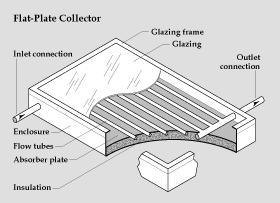flat-plate solar collector

Flat plate collector. Credit: US Dept of Energy.
A flat-plate solar collector is one of three main types of solar collectors, which are key components of active solar heating systems. The other main types are evacuated tube collectors and batch solar heaters (also called integrated collector-storage systems).
Flat-plate collectors are the most common solar collectors for use in solar water-heating systems in homes and in solar space heating. A flat-plate collector consists basically of an insulated metal box with a glass or plastic cover (the glazing) and a dark-colored absorber plate. Solar radiation is absorbed by the absorber plate and transferred to a fluid that circulates through the collector in tubes. In an air-based collector the circulating fluid is air, whereas in a liquid-based collector it is usually water.
Flat-plate collectors heat the circulating fluid to a temperature considerably less than that of the boiling point of water and are best suited to applications where the demand temperature is 30-70°C (86-158°F) and/or for applications that require heat during the winter months.
Air-based collectors are typically used for heating buildings and drying crops. Liquid-based may be glazed or unglazed. Glazed liquid collectors are the commonest type of solar collector for providing domestic and commercial water and for heating indoor swimming pools. Unglazed collectors are most often used for heating outdoor pools. A special type of unglazed collector called a perforated plate collector is used to preheat ventilation air for commercial buildings or, in some cases, for drying crops.
Flat collectors can be mounted in a variety of ways, depending on the type of building, application, and size of collector. Options include mounting on a roof, in the roof itself, or free-standing.
